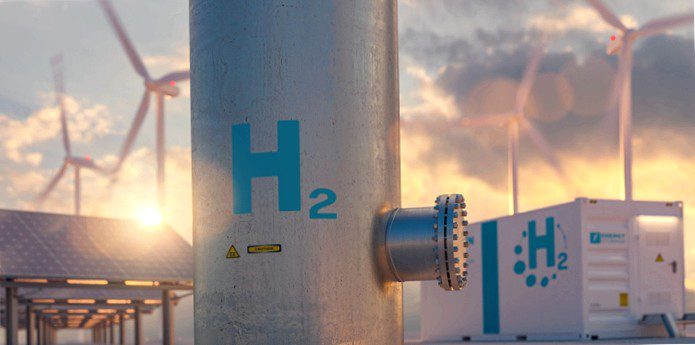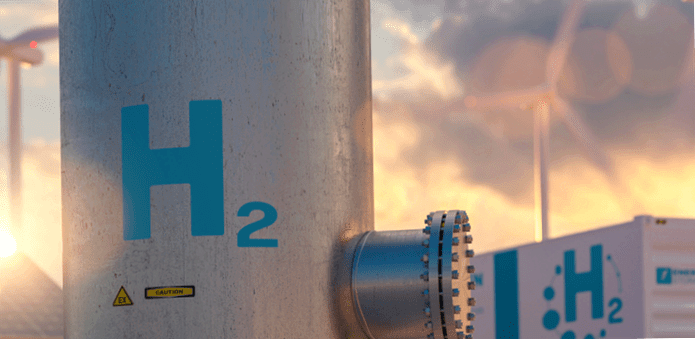Europe is currently in a major energy crisis. The energy and gas prices shoot.

Europe is currently facing a major energy crisis. Energy and gas prices are skyrocketing, and costs are rising across the board. Increasingly, there are calls for renewable energy to provide a sustainable and lasting solution to some of the problems associated with global warming and energy supply.
In these times, it makes sense to examine recent developments in the energy sector. Therefore, in this article we take a look at hydrogen, since the interest in hydrogen energy has increased significantly in recent years. According to the International Energy Agency: “The world has a great opportunity to harness the enormous potential of hydrogen to become an important part of a more sustainable and secure energy future.”

Hydrogen fuel cells and energy storage
Hydrogen has certain aspects that make it a beneficial energy source. Hydrogen can be stored and transported in liquid form on ships or in gaseous form via pipelines. Hydrogen can be produced from a variety of fuels, including renewables, nuclear, natural gas, coal and petroleum. Due to its high energy density, it is an ideal fuel for transport or industry.
Hydrogen fuel cells use hydrogen as a fuel in an electrochemical process that combines hydrogen and oxygen to produce electrical energy and water. It can also be converted into electricity to power homes and industries, and into fuels for cars, trucks, ships and aircraft. Although hydrogen is quite abundant as a natural resource, it is rarely found in its pure form. Pure hydrogen can be produced through chemical reactions.
Currently, most hydrogen is produced by reforming fossil fuels, a process that involves a reaction between natural gas and steam. Hydrogen can also be produced from renewable sources, for example by electrolysis using electricity from renewable sources. Electrolysis used to be a very expensive process, and production costs could exceed the value of production. Technological advances are making electrolysis increasingly cheap, and electricity from wind, solar and hydro power is now widely available.
Another promising development is the conversion of waste into hydrogen (waste-to-hydrogen). Waste-to-hydrogen is a new process that creates value from waste. It is a self-sustaining thermal conversion treatment of organic waste, including plastics, which breaks down the waste materials and extracts the hydrogen they contain. H2-Industries has developed a process using its proprietary technology that can produce large quantities of hydrogen from organic waste at a competitive cost. According to H2-Industries, waste-to-hydrogen is much less expensive than electrolysis, costing only about half as much. Another huge benefit to the environment is the reduction in waste mass as waste is converted to hydrogen.
Therefore “green hydrogen” is, Carbon-free hydrogen produced from electrolysis and waste-to-hydrogen, becoming a real option for transforming the energy market.

The transition to green hydrogen
Green hydrogen produced from electrolysis and renewable energy sources is still a relatively expensive option and currently accounts for only about 5% of total hydrogen production. Although there is an emerging shift towards green hydrogen production due to falling costs, producing hydrogen from fossil fuels is currently still the cheaper option.
Today, hydrogen is mainly used in oil refining and in the production of fertilizers. According to the IEA report “The Future of Hydrogen” causes the production of “gray (from gas) and “brown and black” (from coal) hydrogen (from coal) hydrogen, account for 830 million metric tons of CO2 annually, or about 3% of global greenhouse gas emissions.
To reduce these emissions, many countries, including the US, Canada, the UK, the Netherlands and Australia, are currently investing heavily in blue hydrogen technology. Blue hydrogen is hydrogen produced from natural gas and supported by carbon capture and storage. CO2 produced during the manufacturing process is captured and permanently stored underground so that it is not released into the environment. The result is a low-carbon process for producing hydrogen. The downside is that not 100% of the CO2 produced can be captured and not all storage methods are equally effective over the long term. Switching from blue to green hydrogen would significantly reduce these emissions and long-term problems. As mentioned above, production costs are expected to drop significantly as manufacturing capacity for more efficient and cost-effective electrolysers grows, while new technologies and capacity for renewable power generation are introduced.

The benefits of green hydrogen
Green hydrogen can help address several critical energy challenges, e.g. Store the fluctuating output of renewable energy sources such as photovoltaic and wind power to better match demand. It offers opportunities to decarbonize a wide range of industries and sectors – such as long-distance transport, the chemical industry, and the iron and steel industry – industries that generally struggle to reduce their emissions. In transportation, benefits come from hydrogen fuel cells in trucks and cars, and in shipping and aviation from hydrogen-based fuels. In industries with high CO2 emissions that currently use a lot of coal and where electrification is difficult, such as. B. in the iron, steel and cement industries, emissions can be significantly reduced through the use of hydrogen fuel cells. In addition, hydrogen can be used as a means to store and transport renewable energy, which would support global renewable energy deployment. Finally, it can increase energy security and improve air quality.
One example of the use of hydrogen fuel cells is the electric vehicle market. Hydrogen-powered fuel cell electric vehicles (FCEVs) run on electricity from fuel cells and produce only water vapor as tailpipe emissions. In these vehicles, energy is stored as compressed hydrogen rather than in a battery.
Hydrogen fuel cells convert compressed hydrogen from their tanks into electricity that powers the vehicle’s electric motor, providing a range similar to that of gasoline or diesel internal combustion engine vehicles. Hydrogen-powered cars can travel longer distances than electric vehicles and take only a few minutes to fill up with fuel.

Building the infrastructure
Widespread adoption of hydrogen is hampered by the lack of storage capacity and infrastructure to transport hydrogen on a large scale. Consider the thousands of individual refueling stations needed to fuel hydrogen vehicles. Complicating matters, hydrogen contains less energy per unit volume than any other fuel, so transportation, storage and delivery are more expensive than for a gallon of gasoline. Establishing a new hydrogen pipeline network involves high initial capital costs, and the properties of hydrogen place special demands on the materials used in the pipelines.
The IEA report makes key recommendations to help governments, businesses and other stakeholders move hydrogen projects forward around the world. These include four areas where action can help lay the groundwork for a global clean hydrogen industry:
– Industrial ports should become hubs for increased use of clean hydrogen;
– Building on existing infrastructure, such as e.g. Natural gas pipelines;
– Use of hydrogen to power cars, trucks, and buses operating on major routes;
– Establishment of international hydrogen shipping lanes; and.
IEA report finds hydrogen still faces major challenges. Hydrogen infrastructure development is slow, and some regulations currently limit the development of a clean hydrogen industry. One option could be more decentralized production. Centralized production of hydrogen in large facilities lowers production costs but increases distribution costs. Producing hydrogen at the point of end use, e.g. at refueling stations, lowers distribution costs but increases production costs due to the cost of building on-site production facilities, and could reduce the amount of green hydrogen used because it is easier to produce gray and black hydrogen at many different locations.
The EU also wants to invest more in hydrogen and hydrogen infrastructure. In May 2022, the European Commission published the REPowerEU plan, which outlined the implementation of the European hydrogen strategy, with plans to further increase European ambitions for renewable hydrogen. At the same time, the Commission launched two consultations on two delegated acts that clarify EU rules applicable to renewable hydrogen.
As technological advances reduce the associated costs of production, storage, and transportation, and further investments are made in related infrastructure, large-scale use of hydrogen becomes increasingly likely. Hydrogen could be the best solution for the future of our energy needs, especially as fossil fuels run out.
Attracting hydrogen professionals
To take advantage of opportunities in the hydrogen industry, companies must adapt to the speed of the marketplace. We find that companies tend to continue as they are, missing important opportunities to adapt to new technologies, achieve sustainable goals, and keep pace with the marketplace. To move forward, companies need to attract professionals who are able to implement sustainable strategies. Companies that succeed in attracting new talent act quickly. You close gaps and shorten processes.
Improving sustainability requires multidisciplinary expertise and a high level of coordination to achieve sustainable value creation. Amoria Bond helps companies find the right experts for these positions with proven methods and a wide range of services.
Amoria Bond uses new processes to accelerate the hiring process of highly skilled professionals. Our teams have excellent industry knowledge and will work with you to find the best person for your advanced engineering position. However, our role is not only to find and place talented professionals. We offer specialized recruitment services that encompass much more: From market and competitive analysis to optimizing the entire recruitment process, we cover the full cycle that a new hire requires. Ultimately, all of these aspects help shorten your hiring time, lower your hiring costs, and improve the overall quality of the process.
We are proud of our reputation and track record in placing quality, qualified personnel. Learn more about our recruitment and staffing services and how we can help you.
Do not hesitate and contact my team and me today to learn more about our specialized recruiting services.